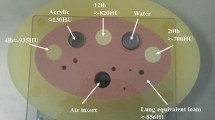Abstract
Purpose
Recently, a reconstruction algorithm for region of interest (ROI) imaging in C-arm CT was published, named Approximate Truncation Robust Algorithm for Computed Tomography (ATRACT). Even in the presence of substantial data truncation, the algorithm is able to reconstruct images without the use of explicit extrapolation or prior knowledge. However, the method suffers from a scaling and offset artifact in the reconstruction. Hence, the reconstruction results are not quantitative. It is our goal to reduce the scaling and offset artifact so that Hounsfield unit (HU) values can be used for diagnosis.
Methods
In this paper, we investigate two variants of the ATRACT method and present the analytical derivations of these algorithms in the Fourier domain. Then, we propose an empirical correction measure that can be applied to the ATRACT algorithm, to effectively compensate the scaling and offset issue. The proposed method is evaluated on ten clinical datasets in the presence of different degrees of artificial truncation.
Results
With the proposed correction approach, we achieved an average relative root-mean-square error (rRMSE) of 2.81 % with respect to non-truncated Feldkamp, Davis, and Kress reconstruction, even for severely truncated data. The rRMSE is reduced to as little as 10 % of the image reconstructed without the scaling calibration.
Conclusions
The reconstruction results show that ROI reconstruction of high accuracy can be achieved since the scaling and offset artifact are effectively eliminated by the proposed method. With this improvement, the HU values may be used for post-processing operations such as bone or soft tissue segmentation if some tolerance is accepted.













Similar content being viewed by others
References
Bier B, Maier A, Hofmann H, Schwemmer C, Xia Y, Struffert T, Hornegger J (2013) Truncation correction for VOI C-arm CT using scattered radiation. In: Proceedings of the SPIE, vol 8668, p 86682F9
Defrise M, Noo F, Clackdoyle R, Kudo H (2006) Truncated Hilbert transform and image reconstruction from limited tomographic data. Inverse Probl 22(3):1037–1053
Dennerlein F (2011) Cone-beam ROI reconstruction using the Laplace operator. In: Proceedings of the fully 3D 2011, pp 80–83
Dennerlein F, Maier A (2012) Region-of-interest reconstruction on medical C-arms with the ATRACT algorithm. In: Proceedings of the SPIE, p 83131B
Dennerlein F, Maier A (2013) Approximate truncation robust computed tomography—ATRACT. Phys Med Biol 58:6133–6148
Dennerlein F, Noo F, Schoendube H, Hornegger J, Lauritsch G (2006) A factorization approach for cone-beam reconstruction on a circular short-scan. IEEE Trans Med Image 27(7):887–896
Fahrig R, Dixon R, Payne T, Morin RL, Ganguly A, Strobel N (2006) Dose and image quality for cone-beam C-arm CT system. Med Phys 33(12):4541–4550
Feldkamp LA, Davis LC, Kress JW (1984) Practical cone beam algorithm. J Opt Soc Am 1:612–619
Hsieh J, Chao E, Thibault J, Grekowicz B, Horst A, McOlash S, Myers TJ (2004) A novel reconstruction algorithm to extend the CT scan field-of-view. Med Phys 31(9):2385–2391
Maier A, Jiang Z, Jordan J, Riess C, Hofmann H, Hornegger J (2013) Atlas-Based Linear Volume-of-Interest (ABL-VOI) image correction. In. Proceedings of the SPIE, vol, p 8668:86682D
Maier A, Scholz B, Dennerlein F (2012) Optimization-based extrapolation for truncation correction. In: 2nd CT meeting, pp 390–394
Noo F, Clackdoyle R, Pack JD (2004) A two-step Hilbert transform method for 2D image reconstruction. Phys Med Biol 49(17):3903–3923
Ohnesorge B, Flohr T, Schwarz K, Heiken JP, Bae JP (2000) Efficient correction for CT image artifacts caused by objects extending outside the scan field of view. Med Phys 27(1):39–46
Pan X, Zhou Y, Xia D (2005) Image reconstruction in peripheral and central region-of-interest and data redundancy. Med Phys 32(3):673–684
Sourbelle K, Kachelriess M, Kalender WA (2005) Reconstruction from truncated projections in CT using adaptive detruncation. Eur Radiol 15(5):1008–1014
Xia Y, Maier A, Dennerlein F, Hofmann H, Mueller K, Hornegger J (2013) Reconstruction from truncated projections in cone-beam CT using an efficient 1D filtering. In. Proceedings of the SPIE, vol 8668, p 86681C
Xia Y, Maier A, Dennerlein F, Hofmann HG, Hornegger J (2012) Efficient 2D filtering for cone-beam VOI reconstruction. In: Proceedings of the IEEE NSS-MIC, pp 2415–2420
Yang J, Yu H, Jiang M, Wang G (2010) High-order total variation minimization for interior tomography. Inverse probl 26(3), ID: 035,013
Yu H, Wang G (2009) Compressed sensing based interior tomography. Phys Med Biol 54(9):2791–2805
Conflict of interest
Yan Xia receives financial support from Siemens AG, Healthcare Sector and Erlangen Graduate School in Advanced Optical Technologies (SAOT). Frank Dennerlein and Sebastian Bauer are with Siemens AG, Healthcare Sector, Germany.
Author information
Authors and Affiliations
Corresponding author
Additional information
The authors gratefully acknowledge funding by Siemens AG, Healthcare Sector and of the Erlangen Graduate School in Advanced Optical Technologies (SAOT) by the German Research Foundation (DFG) in the framework of the German excellence initiative.
Disclaimer Patient datasets were collected for diagnostic purposes during medical interventions. Informed consent was obtained from all patients for scientific use of their data. The concepts and information presented in this paper are based on research and are not commercially available.
Appendix
Appendix
Assume the 1D Fourier transform of \(g_{1}\left( \lambda ,u,v\right) \) with respect to \(u\) is \({\mathcal {F}}_{1}\left\{ g_{1}\right\} \left( \lambda ,\omega _{u},v\right) \), then we can obtain
Applying the second-order derivative to both side of the equation above yields
Then, the inverse Fourier transform of \(\left( \mathrm i 2\pi \omega _{u}\right) ^{2}{\mathcal {F}}_{1}\left\{ g_{1}\right\} \) is equivalent to \(\partial ^{2}g_{1}/\partial u^{2}\) has been shown.
Rights and permissions
About this article
Cite this article
Xia, Y., Dennerlein, F., Bauer, S. et al. Scaling calibration in region of interest reconstruction with the 1D and 2D ATRACT algorithm. Int J CARS 9, 345–356 (2014). https://doi.org/10.1007/s11548-014-0978-z
Received:
Accepted:
Published:
Issue Date:
DOI: https://doi.org/10.1007/s11548-014-0978-z




